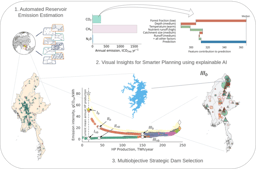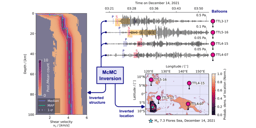Diverse sediment microbiota shape greenhouse gases emission variation in river-lake ecosystems
Published in Earth & Environment

Lakes serve as significant emission hotspots for greenhouse gases (CO₂, CH₄, and N₂O) to the atmosphere. Extensive research has been conducted on greenhouse gas emissions from conventional lakes, which are typically characterized by a relatively stable state. However, for interconnected river-lake systems, the magnitude and controlling factors of greenhouse gas emissions remain unclear. In particular, microbiota have rarely been comprehensively investigated as predictors of greenhouse gas emissions, especially when considered alongside abiotic factors. Interconnected river-lake systems represent highly dynamic, shallow water bodies, distinguished by their intricate hydrological interactions between tributaries and adjacent basins. Understanding the characteristics and determinants of greenhouse gas emissions from these aquatic systems is crucial for accurate quantification and management of greenhouse gas emissions at both regional and global scales. In this study, we selected Dongting Lake as the focal point of study. This lake is a quintessential example of an interconnected river-lake system and the second-largest freshwater lake in China. The lake’s hydrological and hydrodynamic conditions are affected by the combination of more than ten tributaries, including the Yangtze River, the third-largest river in the world. We investigated the greenhouse gas emission characteristics of Dongting Lake and the influence factors on greenhouse gas emissions within this lake systems.
To investigate this, we conducted in-situ sampling over two seasons across Dongting Lake, combined with a global meta-analysis on the basis of 165 lakes over 6 continents. Additionally, we performed Illumina MiSeq sequencing and subsequent statistical analysis to elucidate the influence of both abiotic and biotic factors on greenhouse gas emissions within these lake systems. Exemplified by Dongting Lake, we found that the greenhouse gas dynamics within interconnected river-lake systems exhibit a distinctive temporal flux pattern. Notably, CO2 and N2O fluxes exhibit a negative emission rate during the dry season, then shift to positive during the wet season. These patterns are intricately linked to the complex interconnections and hydrological exchanges between rivers and lakes. In addition, this pattern contrasts with most other lake types documented globally, which typically have higher CO2 and N2O fluxes during the dry season.
More importantly, unlike other conventional lakes, we found that biotic factors were significantly better predictors of greenhouse gas fluxes in Dongting lake than abiotic environmental parameters. We observed that specific microbial species in the sediment, which are important for the cycling of macronutrients and other less common nutrients, alongside microbial predatory behavior, can better predict greenhouse gases fluxes. Given their low relative abundance and specific functions, these biomarker microbiota do not play a direct role in the production and consumption of greenhouse gas, but instead provide substrates or control the dynamics of other microorganisms. For example, the bacterial predators belong to Myxococcaceae, Polyangiales, Haliangium, and Bdellovibrionota in the sediments of Dongting Lake, they may regulate the structure and composition of microbial communities within the sediment through predation or producing a variety of secondary metabolites. This releases carbon, nitrogen, and other nutrients encapsulated in microbial biomass, thereby influencing the emission of greenhouse gases.
In summary, our investigation has revealed distinct patterns of greenhouse gas fluxes within interconnected river-lake systems, and the carbon and nitrogen sequestration capacity during the dry season in these lakes has been underestimated. Furthermore, certain low-abundance and rare species, rather than the commonly assumed environmental factors, emerged as better predictors of greenhouse gas emissions in this complex aquatic system. Our findings advocate a nuanced approach in the estimation of greenhouse gas discharges from varied lake systems, an approach that fully integrates river-lake interrelations and hydrodynamic features. Additionally, biotic elements have emerged as important predictive indicators, necessitating increased attention in subsequent modeling endeavors and flux analyses.
Follow the Topic
-
Communications Earth & Environment

An open access journal from Nature Portfolio that publishes high-quality research, reviews and commentary in the Earth, environmental and planetary sciences.
Related Collections
With Collections, you can get published faster and increase your visibility.
Geology of the Moon
Publishing Model: Hybrid
Deadline: Jan 31, 2026
Drought
Publishing Model: Hybrid
Deadline: Dec 31, 2025




Please sign in or register for FREE
If you are a registered user on Research Communities by Springer Nature, please sign in